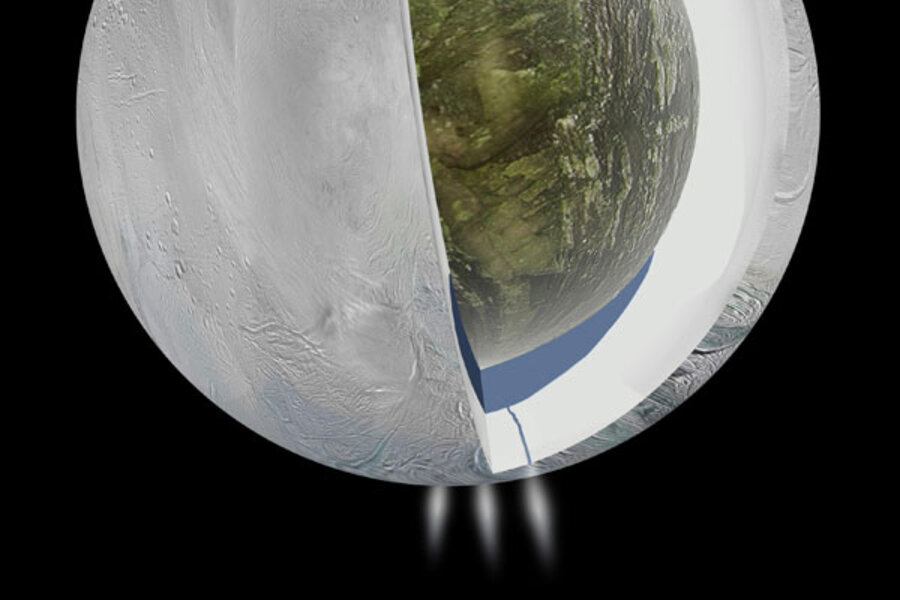Hidden sea on Saturn's moon Enceladus revealed, boosting hopes for life
Loading...
Saturn's tiny moon Enceladus appears to host a regional under-ice sea sporting at least as much water as Lake Superior, according to measurements made by NASA's Cassini spacecraft, which is currently touring Saturn and its moons.
Evidence for the sea is indirect, based on precise measurements of the moon's gravity field. Even so, the measurements allow for a first look at the extent and volume of the sea, a feature that for nine years has been a subject of keen scientific interest and some debate.
Speculation about an under-ice sea blossomed in 2005, when Cassini surprised researchers with images of plumes of ice crystals and dust erupting from long fissures at Enceladus' South Pole.
Because liquid water is a necessary ingredient for life on Earth, the presence of water on Enceladus, coupled with an energy source persistent enough to keep the plumes supplied with fresh material, would suggest that at least for microbes, the moon is potentially habitable, if not already inhabited.
The results solidify Enceladus' role as an attractive hunting ground for future missions focused on identifying potential habitats for life. It shares similarities with its much heftier cousin, Jupiter's moon Europa, which recently made its own headlines after researchers discovered plumes erupting from its surface.
These two moons alone suggest that researchers are confronting "a kind of cornucopia of habitable environments in the outer solar system," says Jonathan Lunine, a planetary scientist at Cornell University in Ithaca, N.Y., and a member of the team that analyzed the gravity data.
"What this discovery tells us is that we need to be more aggressive in getting the next generation of spacecraft both to Europa and to the Saturn system once the Cassini mission is over."
The team estimates that the sea sits beneath about 30 miles of ice and extends from the south pole to at least half way to the moon's equator in every direction. The sea's depth ranges from a few miles to perhaps six miles at its deepest locations. It may even extend farther north, although it would become an increasingly thin layer with distance.
The moon's overall structure consists of a rocky core with a radius of about 125 miles with a layer of water ice about 30 miles thick, according to Cassini data. Scientists believe the sea is sustained between the two largely by tidal heating – the energy imparted to the moon by Saturn's gravity.
Evidence of the sea came from measuring changes in the Cassini's speed as it encountered subtle changes in the Enceladus' gravity. These changes reflect differences in the amount of the moon's mass beneath the spacecraft as it passes overhead, explains David Stevenson, a planetary scientist at the California Institute of Technology in Pasadena and a member of the team reporting the results in Friday's issue of the journal Science.
For instance, if the craft passes over a broad basin in the ice, it would tend to sense less mass than expected if the moon was a uniform sphere. Passing over elevated areas would register more mass than expected.
As Cassini passed over Enceladus' south pole, it detected a drop in mass relative to the region's surroundings, indicating that the region formed a depression. But the mass reading was too large, given the depth and extent of the depression. Something beneath the ice had to be adding as significant amount of mass.
"The natural way to do this it to have a layer of water, because water is more dense than ice," Dr. Stevenson said during a pre-publication briefing on Wednesday. The team was led by Luciano Iess, a professor of aeronautical engineering at Sapienza Università di Roma in Rome.
Even before the release of the gravity data, chemical analysis of the plumes supported the existence of a large body of water, notes Christopher McKay, an astrogeophysicist at NASA's Ames Research Center at Moffett Field, Calif.
Cassini has detected sodium in plume crystals near the moon's surface and tiny particles of silicates throughout the plume and in Saturn's E ring, which is fed by Enceladus' plumes. The sodium suggested a salty water source, while the silicates suggested that the water was in contact with a rocky core.
Chemistry "provided the most compelling evidence that the source of the plume was liquid, and not some sort of snow or ice eruption," as some researchers had suggested, says Dr. McKay, who was not involved in the gravity-field study.
Now, "this gravity data is further evidence that, indeed, the source of the plume is liquid," he says, adding that the presence of liquid "is incredibly important from an astrobiology point of view."
Other mechanisms have been proposed to explain the presence of liquids that would feed the plumes. The friction of tidal heating could provide enough heat to melt some of the ice but not to create a sea. Or the water could have pooled in relatively shallow pockets distributed along the fissures.
Meanwhile, at the other extreme, some researchers had suggested that the moon hosted a global ocean.
Caltech's Stevenson acknowledges that he held the minority view that evidence for an ocean was equivocal at best. But now, "I happen to like the idea of a regional sea because it does fit the data rather nicely and it also makes it easier to understand why the activity is concentrated at the south pole."
His acceptance of a sea on Enceladus is significant, suggests NASA's McKay.
Given Stevenson's initial skepticism, "his acceptance of an idea usually means that it's achieved a high bar of credibility," McKay says.
The Cassini mission currently is expected to operate through May 2017.








